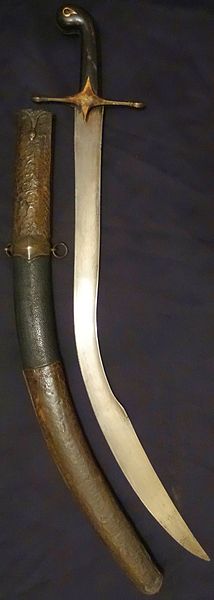The Turco-Mongol sabre, alternatively known as the Eurasian sabre or nomadic sabre, was a type of sword used by a variety of nomadic peoples of the Eurasian steppes, including Turkic and Mongolic groups, primarily between the 8th and 14th centuries. One of the earliest recorded sabres of this type was recovered from an Avar grave in Romania dating to the mid-7th century.
Zhanyinbao, an Imperial bodyguard, wearing a sheathed dao (peidao/waist sabre). (1760)
Three concurrent sword types from the Golden Horde: an arming sword, a long Turko-Mongol style sabre, and an early type of more compact kilij
Three 17th century swords with influence from the Turko-Mongol line: the North African Nimcha, the Indian Tulwar, and the Polish Szabla (Batorówka)
A kilij is a type of one-handed, single-edged and curved scimitar used by the Seljuk Empire, Timurid Empire, Mamluk Empire, Ottoman Empire, and other Turkic khanates of Eurasian steppes and Turkestan. These blades developed from earlier Turko-Mongol sabers that were in use in lands controlled or influenced by the Turkic peoples.
Various kilij from the Hellenic War Museum (Athens, Greece)
Ottoman kilij 19th century; this type with a short, broad blade is known as a "pala"; 27 in (69 cm) blade, 33 in (84 cm) total.
The upper sword appears to be an exaggerated parade piece or executioner's sword, the second down is typical of a later kilij, the third has the characteristics of an earlier kilij and the lowest one possibly has a later European-style blade. Imperial Armoury, Topkapi, Istanbul
Vienna, Treasury of the German Order. Ottoman sabres (17th century)







